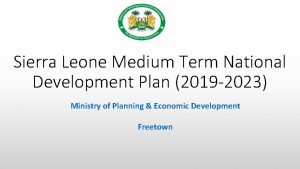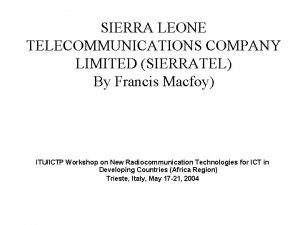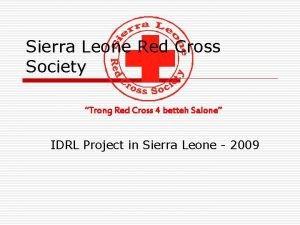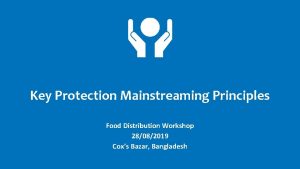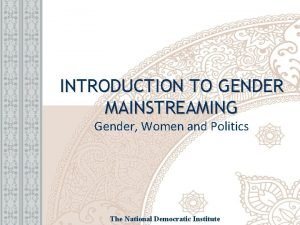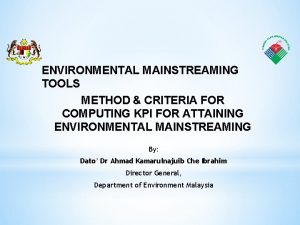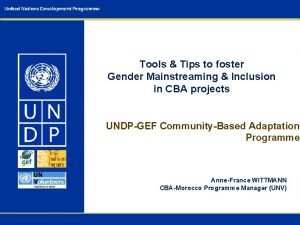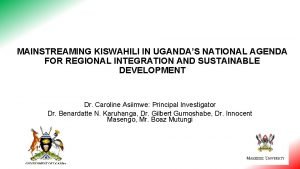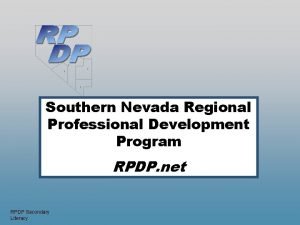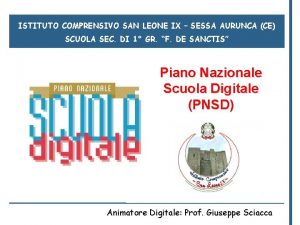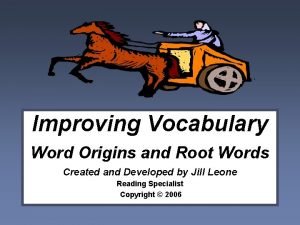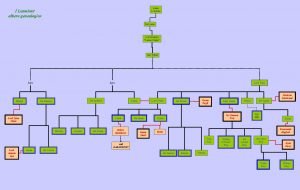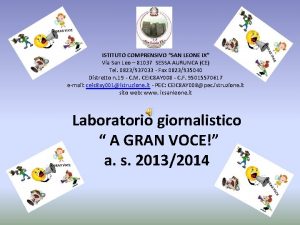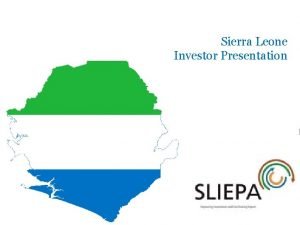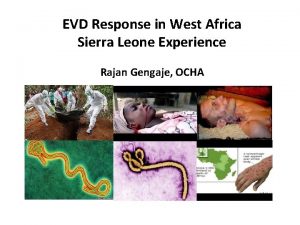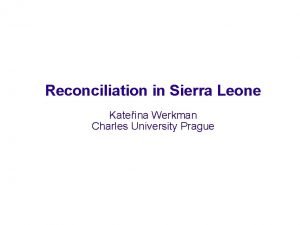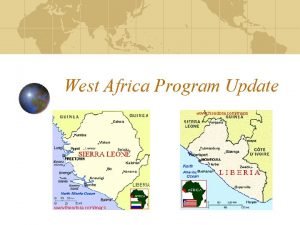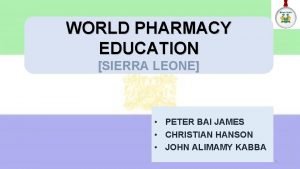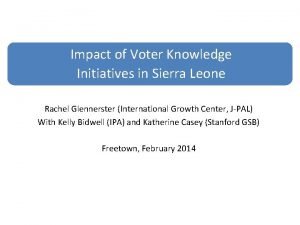Mainstreaming Social Development The Sierra Leone Experience SD



























- Slides: 27

Mainstreaming Social Development: The Sierra Leone Experience SD Days March 30 th, 2005 Dan Owen (SDV) Rob Chase (SDV) Yongmei Zhou (AFTPR) Samantha de Silva (HDNSP) Dan Murphy (SDV) Camilla Holmemo (SDV)

What are the SD strategic priorities again? p Overall Social Development Objective n n n p Empowering poor and marginalized men and women… Through a process of transforming institutions… For greater inclusion, cohesion and accountability Strategic priorities n n n More Macro: Clients incorporate SD into strategies and policy dialog Better Projects: Comprehensive and efficient mainstreaming of SD into project-level processes Better Grounding: Improve research, capacity building and partnerships

Sierra Leone and Social Development: So What? Sierra Leone embodies some promising examples to mainstream social development into operations p More Macro: n SD Principles of inclusion and accountability incorporated into the CAS p Better Projects: n Constructive synergies between decentralization & CDD p Better Grounding: n Operational research on social development impact p

Sierra Leone: The Context Social Assessment 2004: better understand poverty and vulnerability in order to strengthen CDD p Findings: p Ø Ø p Widespread practices of social exclusion Youth marginalization exacerbated by 11 -year civil war Communities divided between leading lineages and the rest Weak institutional structures from grassroots to national level Need: reestablish mutual trust through inclusive and accountable governance

Sierra Leone: The CAS Three pillars: governance, pro-poor sustainable growth, human resource development p Governance pillar supports two promising entry points of governance reform p n n Decentralization and empowerment Public financial management reform

Extreme poverty outside Freetown

Go. SL vision of Decentralized Governance May 2004 Election of local councils p Local Government Act 2004 requires p n n Devolution of functions, expenditures, revenue authorities to local councils during 2004 -2008 Inter-governmental transfers based on transparent formula and principle of equity Local councils autonomy in HRM and FM under guidelines Transparency and accountability in council operation

CAS Helps Go. SL Establish Effective Local Governance p p Support fiscal decentralization to empower LGs with power and resources (IRCBP) Build LGs capacity in inclusive development planning, accountable financial management and effective service delivery (IRCBP) Empower communities to effectively express demand for public services and hold LGs accountable (IRCBP, JSDF, Dev. Comm) Promote inclusive decision making processes within communities, empower communities to undertake collective action and address own development challenges (NSAP, JSDF)

CAS Helps Go. SL Improve Transparency and Accountability of Public Financial Management Improved strategic orientation of budget (IRCBP, Development Policy Lending) p Improved transparency of overall government resource envelope and allocation (IRCBP, DPL) p Improved accountability of spending units (IRCBP, DPL) p We expect Df. ID ENCISS Project to help strengthen the monitoring and advocacy capacity of civil society groups p

Institutional Reform and Capacity Building Project (IRCBP) – Decentralization Component Facilitating and financing Local Council Rapid Results Initiatives: immediate disbursement to finance RRIs, implemented within 100 days. p Build functioning LGs which can p n n p institutionalize participatory planning have basic FM capacity establish local revenue mobilization capacity first maintain and later expand/improve service delivery Reward LGs which adopt a transparent and accountable management culture

Institutional Reform and Capacity Building Project – Decentralization Component (2) Block grants to LGs so they can practice discretionary resource management skills p Access rules focus on transparency and accountability requirements of LG Act 2004 p Allocation of formula-based LGDG among LGs based on equity principle: infrastructure needs, other financing available p Establish a credible transfer system for other financiers to use in future p

IRCBP: Lessons Learned p p p Promoting inclusion and strengthening accountability is about changing people’s belief and behavior. How do we do it? Nurturing inclusion and accountable governance culture in new LG institutions through n Legal framework n Processes n Values n Incentives n Provide immediate reinforcement through publicity and peer pressure Key to start with virtuous cycle

IRCBP: Lessons Learned (2) p p Strengthening accountability and promoting inclusion in entrenched system may face more challenges. Need to disturb equilibrium, e. g. , supporting champions for change within government and in society.

National Social Action Project (NSAP) PDO To empower communities in the process of selection, rehabilitation/construction and operation of social and economic infrastructures p Targeting especially the most vulnerable groups of society and in the areas most affected by the conflict or underserved by the government p Supporting communities in taking collective action for social change. p

NSAP COMPONENTS Community Driven Program: Provision of social services and economic infrastructure (primary schools, health posts, rural water, village roads, sanitation, small projects in agriculture, markets). p Public Works. Finances shelter and feeder roads. (Only in three most vulnerable districts: Kano, Kalahun and Koinadugu). p Management and Innovative Activities. Information, public education, communication, capacity building p

NSAP: Strategy for Reaching the Vulnerable p Targeting n n n p p District level. Resource allocation using vulnerability targeting (areas most affected by conflict, newly accessible areas) Below district level. Targeting strategy uses Services and Opportunities Mapping to compare vulnerability across chiefdoms and wards. Community level. Targets poor/remote communities. PPA and mobilization process ensures inclusion of VGs (e. g. , returnees, IDPs, former combatants, widows, orphans). Shelter Component – Works through NGOs. Finances shelter for vulnerable groups/families (amputees, disabled, widows etc. ). Sensitizes communities on related issues. Project uses specific indicators to track social inclusion and vulnerability.

NSAP: Criteria for Vulnerability Ranking (Below District level) p p Population Education p Health Water Agriculture p Natural resources p Transportation Commercial activities p p p Civic facilities Support (based on 2004 ranking) (operating standard education facilities) (operating standard health facilities) (availability of potable water) (availability of agricultural services, rating of agricultural activities) (rating of availability of natural resources) (rating of accessibility) (prevalence commercial opportunities and activities) (availability of civic facilities) (rating of NGOs/GOSL support)

NSAP: RESULTS p Reaching most vulnerable areas (conflict affected/newly accessible): n n n p p p 33% of CDP projects in most vulnerable districts (target over 50%) PWP/Shelter. 388 shelters rehabilitated benefiting 6, 294 beneficiaries. MOU –SLRA, DCs, Na. CSA- signed to rehabilitate 100 km of feeder roads (30 -40 roads) CDP financed 175 subprojects in poor/remote communities. Communication campaign focuses on social cohesion and community participation. Measuring impact. Developing common set of social capital indicators (trust, inclusion, networks etc. ) jointly with IRCBP and JSDF.

NSAP: Addressing Accountability Issues p Communities given full control over decisions and resources. n n n p p PMCs accountable to the greater community Transparent procedures/rules in place Internal audits of community accounts PPA and social mobilization process promotes transparency and accountability at all levels. Strengthens links between local councils and communities Information campaigns publicizes info about Na. CSA (operating procedures, “rules of the game”, budgets, achievements, etc. ) Na. CSA fully accountable to parliament.

Empowering the Grassroots: Capacity Development to Strengthen Social Capital (JSDF) Objectives: “Learning by doing” via bottom-up support to decentralization (IRCBP link) p Address Social Assessment finding of fragile social capital: inclusion, trust, collective action, groups and networks, information and communication (NSAP link) p Scope: p 2 year pilot in Bonthe and Bombali Districts; n Operates in 60 villages, 10 wards per district. n Recipient: Decentralization Secretariat

Empowering the Grassroots: Capacity Development to Strengthen Social Capital (JSDF) Design Highlights: p Development Planning at village and ward levels n Strategic plans, identify concrete goals and action steps to achieve them Community-Driven Initiatives at village and ward levels n Via Development Grants n Results oriented, will use successful model of RRI p Community Driven Monitoring and Evaluation (CDME) n Communities choose indicators, track progress, and make changes when necessary n Simple, effective management tool p

JSDF: Pre-requisites for Inclusion and Accountability p Political will of key national stakeholders critical p Support institutional structures at lower levels that can be sustained n In Bombali District, average of 45 villages per ward p Quality technical design: simple, relevant, and scaleable approaches p Engage most vulnerable: youth and women

JSDF: Operational Value Added vis-àvis Inclusion and Accountability Mobilization process allows communities to examine intangibles (i. e. inclusion, accountability), that are reflected in planning and action p Support behavioral change by fostering a culture of inclusion and accountability at community level p Management of Development Grants p n p Financial accountability via “learning by doing” Community-Driven Monitoring and Evaluation: n Inclusion and Accountability: explicitly and implicitly

JSDF: Lessons Learned? p “Process” – nice rhetoric; Is it doable? Necessary? p In terms of addressing urgent development needs, “Subsidiarity Principle” may not yet trickle down to community level. A proactive approach in short- to medium-term necessary. p Sustainability of village/ward level block grants questionable in short-term. Key is to demonstrate absorptive capacity of sub-district structures to Local Councils, Go. SL, donors.

Are We Really Supporting Inclusion and Accountability? Joint Impact Evaluation p p p Empowering people, transforming institutions, promoting inclusion and accountability? Joint Impact Evaluation Impacts on inclusion Ø In development planning and implementation Ø Inclusive leadership/decision-making Impacts on accountability Ø Public spending and services Ø Communities empowered to hold leadership accountable

Supporting Inclusion and Accountability: How did we do? p Relative pros and cons Ø Ø p Which approach is more effective in promoting inclusive and accountable local governance? Value added of participation? How are we going to do this? Ø Ø Annual household surveys to track before/after Targeted quality studies in key sectors Annual Public Expenditure Tracking Surveys JSDF: Randomized impact evaluation – qualitative + quantitative

Operational research on SD impact – so what? Better grounding: operational research and capacity building p Better projects: careful downstream analysis p More macro: build capacity to link operations to policy through research and analysis p
 Medium term national development plan
Medium term national development plan Sierra leone telecommunications company
Sierra leone telecommunications company Sierra leone
Sierra leone Who is dr tamba in a long way gone
Who is dr tamba in a long way gone Protection mainstreaming principles
Protection mainstreaming principles What is gender mainstreaming?
What is gender mainstreaming? What is gender mainstreaming?
What is gender mainstreaming? Environmental mainstreaming tools
Environmental mainstreaming tools Sex videao
Sex videao Gender mainstreaming
Gender mainstreaming Mainstreaming in swahili
Mainstreaming in swahili Sierra workforce solutions
Sierra workforce solutions Imprinting psychology
Imprinting psychology Early experience vs later experience
Early experience vs later experience Direct and indirect experience
Direct and indirect experience Jill leone
Jill leone Cosa sono le meduse
Cosa sono le meduse Icsanleoneix
Icsanleoneix Acle suffix meaning
Acle suffix meaning Lannister albero genealogico
Lannister albero genealogico Istituto comprensivo san leone ix
Istituto comprensivo san leone ix Coalbrookdale di notte
Coalbrookdale di notte Who is regarded as the father of forensic science?
Who is regarded as the father of forensic science? Trilogija gospoda glembajevi
Trilogija gospoda glembajevi Calvin goddard biography
Calvin goddard biography Paola leone unisalento
Paola leone unisalento Hocum
Hocum Benzopironi
Benzopironi
